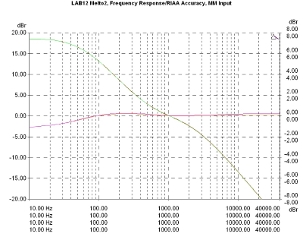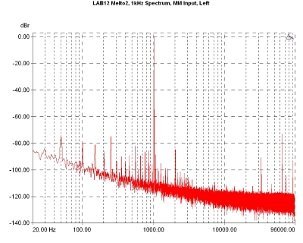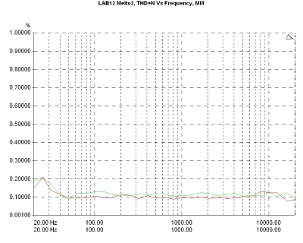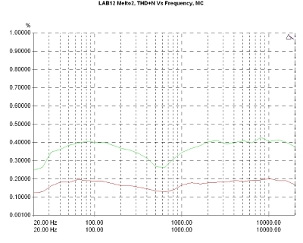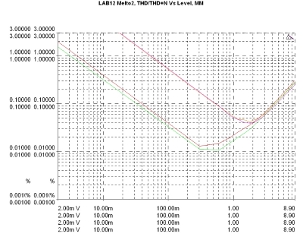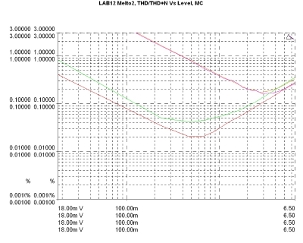about Audio, High Fidelity
& Home Entertainment technologies
pid: 607-2025/10/01 (v1.2)
Privacy Policy
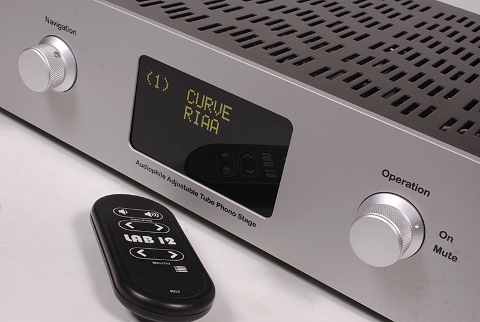
During lab evaluation, both moving magnet (47kΩ/100pF) and moving coil (100Ω/High Gain) settings were used. In all cases (except for obtaining the three de-emphasis curves) the equalization applied was the standard RIAA. All measurements were made through the single-ended output.
For an output level of -10dBV (316mVrms), the preamplifier required 3.14mVrms in MM mode and 0.186mVrms in MC mode, confirming the company's claim of 38dB and 64dB gain respectively. Overload margin proved to be particularly high since metlo2 required 88.3mVrms in MM mode (for 8.8Vrms output) and 3.4mVrms in MC mode (for 5.7Vrms output) to start showing some overload signs.
Distortion figures were also good. Relevant measurements were 0.007% (THD) and 0.076% (THD + N) in MM mode and 0.023% (THD) and 0.781% (THD + N) in MC mode. The preamplifier proved to be one of the best we have measured up to this day in signal to noise ratio, at -72.2dBr(A) in MM mode and -54.7 dBr(A) in MC mode, with a reference level of -10dBV.
RIAA de-emphasis accuracy is quite good, with a maximum deviation at about 0.39dB (towards the lower part of the audio spectrum, at the 3180μS time constant) with the other time constants showing significantly lower deviations (0.22dB at 318μS and 0.08dB at 75μS). The two channels are extremely well balanced, with the maximum deviation (at 75μS) not exceeding 0.07dB, a performance which is justified by the very strict selection procedure applied for the passive components used in the equalization network.
In the relevant graphs, one can observe both the practically zero deviation between the two channels and the very small deviations from the standard values (the later displayed on the right vertical axis).
The comparison of the three de-emphasis curves offered by melto2 (RIAA, Decca, and Columbia) shows the expected small differences between the three transfer functions and one can implicitly conclude that the two other curves offer similar accuracy to that of the RIAA curve.
RIAA equalization curve (green and red) and RIAA accuracy graph (inverse RIAA compensated response, orange and violet).
Available de-emphasis curves. RIAA (green), Columbia (red), Decca (orange).
The output spectrum, with a 1kHz signal in MM mode and with a reference level of -10dBV, includes an obvious second harmonic (near -85dBr) and practically negligible traces of harmonic distortion above it, as the remaining components are masked by the noise in the graph.
The noise spectrum (in reference to -10dBV output) is fairly standard and confirms the noise measurements, mentioned above. There are some hum fundamentals (50Hz and 100Hz) in the -80dBr range, as well as some related intermodulation components, decreasing fast with frequency, and some frequency peaks, towards the top limit of the spectrum, that may be due to the microprocessor and the display operation, all at a very low level.
Output signal spectrum for 1kHz input.. Reference level: -10dBV/MM mode.
Noise Spectrum. Reference level: -10dBV/MM mode.
The total harmonic distortion and noise (THD+N) in relation to the signal frequency graph, shows a particularly smooth behavior, with the performance in MM mode being around 0.1% for both channels and in MC mode not to exceed 0.4% (left channel) and 0.2% (right channel).
THD+N Vs Frequency. Reference level: -10dBV/MM mode.
THD+N Vs Frequency. Reference level: -10dBV/MC mode.
The THD+N versus level graph, in MM mode, is quite standard in form. One will notice that the best performance of the device (THD close to 0.01%) is achieved for output levels around and slightly above -10dBV, the nominal Line level. From this point onward, the distortion progressively increases until the first clipping signs (at 0.3%).
Not unexpectedly, a similar behavior was observed in MC mode, with the additional comment that here the distortion values are higher in both the THD and the THD + N measurement.
Distortion Vs output level. THD (green/red), THD + N (orange/violet). Frequency: 1kHz, MM mode.
Distortion Vs output level. THD (green/red), THD + N (orange/violet). Frequency: 1kHz, MC mode.
Previous | Next | More Reviews

